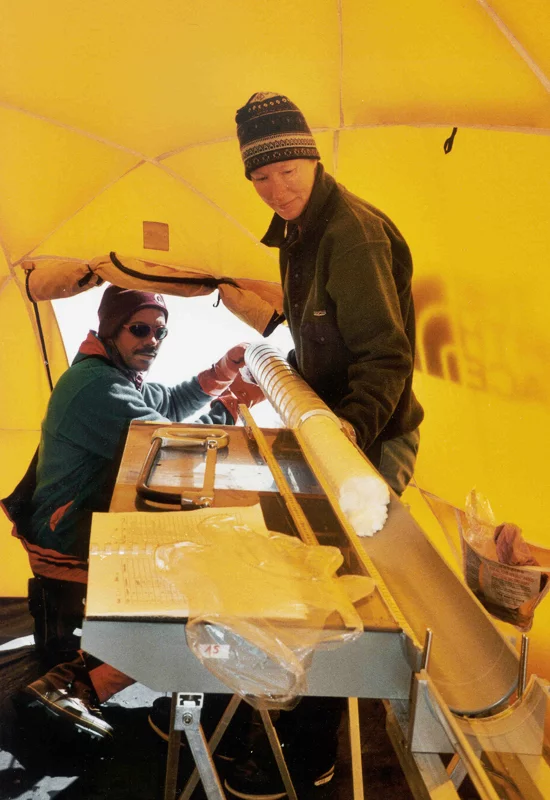Information about the climate and the composition of the atmosphere during past centuries can be locked up in glacial ice – in Antarctica and Greenland, as well as in the high mountains. Such glaciers arise in cold regions getting a lot of snow when new layers of snow gather over the years and are increasingly compressed by their own weight. In this way, glaciers gather information on volcanic eruptions, storms in the Sahara, forest fires, environmental pollution and even temperatures in the past. To get at the information stored in these glaciers, researchers from the Laboratory for Radiochemistry and Environmental Chemistry at the Paul Scherrer Institute regularly undertake research expeditions to different regions – the Swiss Alps, the Altai mountains in Central Asia, South America or Spitsbergen – to take ice core samples. An ice core sample is a column of ice which is extracted from a glacier in 70 cm long segments by drilling, and which ideally extends as far down as to the surface of the underlying rock. The ice core must then be transported in a frozen state to the laboratory in Villigen, where it provides numerous scientists with insights into various aspects of the climate in the past.
Obtaining these insights is an extremely complex process. The ice core is first divided into several sections, which are intended for researchers interested in various aspects of the history of the atmosphere. Every scientist who receives a piece of the core must first cut it into several thousand thin slices in a cold room at minus 20 degrees Celsius. Each slice is then melted and its chemical composition tested, in order to determine the concentration of certain substances in the atmosphere in the past – for example, ash from volcanic eruptions or substances that enter the atmosphere through industrial production.
Before the actual tests, however, a further difficult undertaking is necessary, namely dating – i.e. determining what periods in time the different layers of the ice core represent. Very often, one can actually count layers similar to tree rings corresponding to individual years. This can be accomplished by determining the concentrations of substances showing a high concentration in summer and a low concentration in winter. Also historically documented events that leave their traces in the ice can help date an ice-core, such as violent storms that carried dust from the Sahara to glacial mountain regions. The lowermost regions of an ice core are difficult to date. In these cases carbon dating can be used.
Past temperatures
An ice core not only reveals information about the chemical composition of the past atmosphere. Changes in temperature also leave their signs in the ice. To find these signs, a researcher looks at the oxygen in the water molecules of the ice (the O in H2O), which occurs in two isotopic forms: as 16O and as the somewhat heavier 18O. When water evaporates, water molecules with 16O rise more readily from the liquid water than the other form, so the proportion of 16O is higher in the vapour than in the water. On the other hand, the heavier molecules condense first. These effects mean that the ratio of the concentrations of heavier and lighter molecules in glacial ice may depend on the local temperature. But whether or not it really does first has to be tested in the individual case because further factors could influence the quantitative ratio of the two isotopes.
Studies on an ice core which PSI scientists drilled from the Siberian Altai Mountains in 2001, provides interesting results about climate change in areas with a particularly continental climate. The development of the 18O/16O ratios observed in the ice core was in good agreement with existing temperature measurements of the past 150 years. It was therefore assumed that this ratio also reflects the correct temperature further back in time. Thus measuring the concentrations of the oxygen isotopes enabled the temperature curve to be reconstructed back to the year 1250. The researchers concluded from these results that the temperature in the Altai followed the fluctuations in solar activity up to about 1850 with a delay of around 20 years. Yet the rise in temperature observed since then cannot be explained by the fluctuating influence of the sun alone, but has to be attributed to a significant degree to the greenhouse gases generated by humankind.

